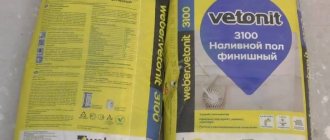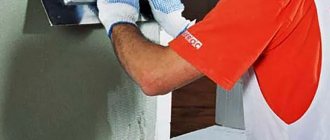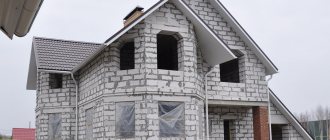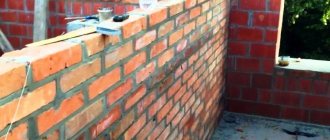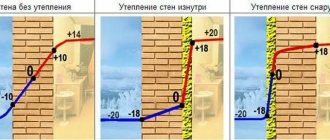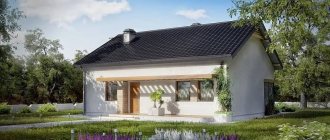Aerated concrete is the most popular building material due to its thermal characteristics, low cost and high speed of wall construction.
One of the most important questions when building a house is the following: “how thick should a wall made of aerated concrete be?” After all, the issue of saving money on heating is more relevant than ever. To answer quickly, the thicker the wall, the stronger it is, and the better it retains heat. But not everything is so simple; economic feasibility is important.
In addition to its thickness, the thermal engineering of a wall is also influenced by the density of aerated concrete. The lower the density, the better the heat is retained. Most likely, you would just like to know how thick the aerated concrete wall should be, but in addition to all of the above, the choice of wall thickness is also influenced by the region in which you live, since the difference in temperatures between Siberia and Sochi is huge.
For central Russia, it is believed that the wall’s resistance to heat transfer (according to SNIP) should be about 3.2 W/m•C°. For colder regions of the country, this figure should be higher. Please note that for private construction, it is not necessary to comply with these standards.
Such thermal protection (3.2 m2 C°/W) is provided by the following options for single-layer aerated concrete walls.
- D300 – 300 mm.
- D400 – 400 mm.
- D500 – 500 mm.
It is worth noting that the overall thermal efficiency of a building is affected not only by the walls, but also by the insulation of the floor, roof, ceilings, reinforced belts, lintels, and windows. It follows from this that the heat loss of the building through the walls ranges from 30 to 40%. That is, making walls that are too thick is not rational. We need some balance between the costs of wall thickness and heating the house.
If we are talking about a permanent residence, then at current heating costs, the optimal thickness of a single-layer aerated concrete wall is: D400 - 400 mm, D500 - 500 mm.
For a country house that is visited quite rarely, a wall with a thickness of 250-300 mm made of D400 aerated concrete will be sufficient.
How thick should a wall made of aerated concrete be?
Aerated concrete is the most popular building material due to its thermal characteristics, low cost and high speed of wall construction.
One of the most important questions when building a house is the following: “how thick should a wall made of aerated concrete be?” After all, the issue of saving money on heating is more relevant than ever. To answer quickly, the thicker the wall, the stronger it is, and the better it retains heat. But not everything is so simple; economic feasibility is important.
In addition to its thickness, the thermal engineering of a wall is also influenced by the density of aerated concrete. The lower the density, the better the heat is retained. Most likely, you would just like to know how thick the aerated concrete wall should be, but in addition to all of the above, the choice of wall thickness is also influenced by the region in which you live, since the difference in temperatures between Siberia and Sochi is huge.
For central Russia, it is believed that the wall’s resistance to heat transfer (according to SNIP) should be about 3.2 W/m•C°. For colder regions of the country, this figure should be higher. Please note that for private construction, it is not necessary to comply with these standards.
Such thermal protection (3.2 m2 C°/W) is provided by the following options for single-layer aerated concrete walls.
- D300 – 300 mm.
- D400 – 400 mm.
- D500 – 500 mm.
It is worth noting that the overall thermal efficiency of a building is affected not only by the walls, but also by the insulation of the floor, roof, ceilings, reinforced belts, lintels, and windows. It follows from this that the heat loss of the building through the walls ranges from 30 to 40%. That is, making walls that are too thick is not rational. We need some balance between the costs of wall thickness and heating the house.
If we are talking about a permanent residence, then at current heating costs, the optimal thickness of a single-layer aerated concrete wall is: D400 - 400 mm, D500 - 500 mm.
For a country house that is visited quite rarely, a wall with a thickness of 250-300 mm made of D400 aerated concrete will be sufficient.
Exact calculation
You can find out the weight of the block using a geometric formula, the parameters of which depend on the dimensions of the material and density, namely m = V multiplied by p, where:
- m is the weight indicator;
- V—volume;
- p—density.
Aerated concrete is a building material that is very popular due to its properties. It can be used for the construction of houses and industrial facilities. When choosing such a product, you need to know its size, density and weight.
We will also consider its advantages over other building materials.
Thickness of aerated concrete with insulation
Now as for multi-layer walls, that is, insulated. Stone wool, polystyrene foam and low-density aerated concrete are usually used as insulation materials.
By using insulation, the thickness of load-bearing walls can be reduced, achieving a certain value of thermal resistance. That is, the cost of aerated concrete will decrease, but the cost of insulation will increase. Thus, you need to look for a balance between the thickness of aerated concrete and the cost of materials for insulation.
To make it easier for you to decide on the thickness of aerated concrete and insulation, we have found tables on the thermal parameters of wall materials.
Heat transfer resistance (R0) of aerated concrete depending on the thickness of the masonry.
The higher the value, the better.
Table (thermal conductivity coefficient of aerated concrete)
The lower the value, the better.
For greater clarity, let's make calculations.
For example, you want to build a house in the Moscow region. The required value for thermal resistance in Moscow is R=3.28 . Your house is made of autoclaved aerated concrete D500 with a thickness of 300 mm, and you need to decide on the thickness of the insulation.
The thickness of the aerated concrete wall (0.3 m) is divided by the thermal conductivity coefficient of aerated concrete D500 (0.14).
Thermal resistance of the wall R = 0.3/0.14 = 2.14 m2 °C/W.
Next, we subtract the resulting thermal resistance R (2.14) from the required value R(3.28).
This means the thermal resistance of the insulation should be 1.14 m2 °C/W.
Thermal conductivity coefficient of mineral wool = 0.04.
Multiply 1.14 by 0.04 = 0.0456 meters, that is, 45 mm.
That is, the required insulation thickness was 50 mm.
Thus, you can calculate the required insulation for any wall.
Block classification
Aerated concrete is a porous building material. It contains: cement, lime, aluminum powder, quartz sand and water. During the process of mixing and making blocks, a reaction occurs that produces hydrogen. The mixture is then subjected to vibration and hardens. Blocks of the required size are cut out of a large solidified mass. Their width can be from 7.5 to 50 centimeters. Length from 60 to 62.5 centimeters. Height from 20 to 25 cm.
When choosing sizes, it is necessary to take into account the purpose and size of the building, seasonality of use, service life and monetary costs. And only after this should you choose the thickness of the blocks, since this will determine the heat, sound insulation and much more.
Main types
The requirements for blocks in terms of strength and thermal insulation may be different and they depend on what kind of room will be built. If this is a non-residential building, then it is necessary that the walls are simply strong, but when constructing a residential building, it is important to take everything into account. There are several types of aerated concrete block:
- Thermal insulation . The density of such a block is 300-500 kg/m3. This type is suitable for the construction of self-supporting walls or it can be used as additional insulation.
- Structural . Density - from 1000 to 1200 kg/m3. It is light in weight, so it is used for the construction of large objects.
- Structural and thermal insulation . Density - from 500 to 900 kg/m3. This type is suitable for the construction of low buildings. It is considered a warm and durable material.
This building material, when used correctly, has a lot of advantages. The main thing is to take into account its main characteristics and coordinate it with the conditions and location of construction.
Material Density
The density of a block is determined by its weight and is designated by the Latin letter D, and the numbers indicate the width. For example, grade D 500 represents a block with a width of 50 cm. There are several grades of density (D):
Related article: Wall-mounted spice rack
- D 50, D 100, D 250 - have a minimum density, so they are best used for laying interior walls without loads.
- D 300, D 400 - used for the construction of load-bearing walls. This brand can be recommended for the construction of two-story houses.
- D 500, D 600 - are highly resistant to frost, their price is much higher than previous brands. Suitable for laying facade walls of a three-story house.
- Grades from D 600 and above are recommended for the construction of durable special structures.
Density must be taken into account first of all when calculating the load on the foundation of a building at the initial stage of work.
Weight of 1 m3 of aerated block, formula for calculation, characteristics, price per cubic meter
- Weight of aerated concrete
- Calculation example
- Price
Weight of blocks of different sizes
According to their purpose, gas silicate blocks are divided into:
A practical option for a 1-floor residential building would be the D500-D600 brand. Dimensions also affect weight, so blocks measuring 600x300x200 mm will weigh more than 300x100x100, provided they have the same density.
Typical calculation of the mass of aerated concrete
The weight is determined using the example of a block 600x250x400 mm. The formula for calculation is as follows: density (kg/m3) x volume (m3) = mass (kg).
This method can be used for any size of gas blocks of different densities. However, it is important to consider the load that will affect the foundation.
Regulatory Requirements
In order to understand what thickness a wall made of aerated concrete should be, first of all you should familiarize yourself with the regulatory requirements for the use of aerated concrete blocks, which are regulated by the document STO 501−52−01−2007. This document contains all the necessary recommendations:
- Height of buildings. For a load-bearing wall, the maximum height is 20 meters. And for self-supporting ones - no more than 30 meters.
- The strength of the blocks must be at least B3.5 during the construction of a house with five floors, and a mortar of class M100 is used. For a three-story building - B2.5 with M75 mortar. And for a two-story building, the strength class of the block should be B2 using M50 mortar.
Based on these requirements, the main indicators of the designed structure are calculated.
Optimal wall thickness
You can build anything from aerated concrete, but when constructing residential buildings, important recommendations must be taken into account. When constructing low-rise buildings, the main purpose of which is living in the summer, you must adhere to certain rules:
- When building a one-story house in warm areas, the thickness of aerated concrete blocks should be at least 20 cm.
- For high-rise buildings, a gas silicate block 30 cm thick is required.
- For the base and basements from 30 to 40 cm, but for these purposes it is better to choose another material, since aerated concrete is afraid of moisture.
- Interior partitions should be at least 15 cm, and between apartments - from 20 to 30 cm.
The thickness of the aerated block for a house that will be built for permanent residence depends on the climatic conditions of the area. With the correct calculation, you don’t even need to use insulation. And to make it easier, experts have already calculated the heat transfer resistance for some regions: Astrakhan region - 2.1, Altai - 3.5, Volgograd region - 2.8, Moscow region - 3.29, Chukotka - 4.9, St. Petersburg - 3.29, Krasnodar Territory - 3.5.
These indicators are calculated for the construction of buildings without the use of insulation. But if you still plan to make walls with insulating material, then calculating the thickness of aerated concrete blocks for external walls is even easier. In this case, only the quality and density of the material can be taken into account.
Numbers
You can read how to use blocks for internal partitions from the article.
You can find out what the price and characteristics of a gas block are by reading this article.
You can find out the opinion of experts about whether a foam block or a gas block is better by reading this article.
If you want to save money, then when purchasing you need to take into account the dimensions of the product, as well as correctly calculate the quantity. To avoid such problems, you should carefully study all types of aerated concrete and its sizes.
You can find out whether a foam block or a cinder block is better by reading the article.
The difference between a foam block and a gas block is indicated in the description of the article.
The video explains how to calculate the weight of a house made of aerated concrete:
The thickness of aerated concrete walls - the best options
Aerated concrete block products differ from conventional concrete in their low thermal conductivity. This quality is achieved by the presence of aluminum powder in the feedstock. Hydrogen bubbles spread throughout the hardening mass, which allows aerated concrete to transfer less heat than concrete. But this advantage is fraught with a decrease in strength, which is relevant when comparing blocks with concrete analogues. Based on this, the thickness of aerated concrete walls is determined taking into account the required level of thermal insulation and structural strength. And here there is another important feature - full compliance with the existing budget.
Load-bearing wall thickness
The construction of any object is preceded by strength calculations. It is not always possible to perform such actions on your own; for this reason, it is allowed to use parameters that determine strength.
The thickness of the load-bearing wall is determined taking into account these data.
Another important factor is the purpose of the facility being built. If the house is low-rise and is intended to be used during the summer season, it is recommended to comply with a number of simple requirements:
- when constructing a one-story building in an area with a warm climate, a garage and other outbuildings, aerated concrete 250 mm thick is used;
- for two- or three-story buildings this parameter increases to 300 mm;
- when constructing basements or ground floors, the recommended wall thickness is from 30 to 40 cm. But remember that aerated concrete is afraid of abundant moisture, so it is necessary to use other materials.
If the construction of a facility intended for year-round living is meant, the strength indicator is not enough. In this case, the thermal conductivity of the material is taken into account. Using calculations, the minimum thickness of an aerated concrete wall is determined, or the same parameters remain as for summer houses, but the external walls are additionally insulated. In this case, the calculation is carried out according to the available money - a more profitable option is determined. Either the thickness of the load-bearing aerated concrete wall is increased, or insulation is used.
When determining the cost of insulation material, do not forget about fasteners and the cost of specialist services.
Thickness of partition walls
This parameter is selected taking into account certain factors, the load-bearing capacity is calculated and the height of the partition is taken into account.
When choosing blocks for such walls, you should pay close attention to the height value:
- if it does not exceed the three-meter mark, then the optimal wall thickness is 10 cm;
- when the height increases to five meters, it is recommended to use blocks whose thickness is 20 cm.
If there is a need to obtain accurate information without performing calculations, you can use standard values, which take into account connections with the upper floors and the lengths of the walls being erected. Particular attention is paid to the following tips:
- when determining the operational load on the internal wall, it becomes possible to select optimal materials;
- for load-bearing partitions, it is recommended to use D 500 or D 600 blocks, the length of which reaches 62.5 cm, the width varies from 7.5 to 20 cm;
- the installation of conventional partitions involves the use of blocks with a density index of D 350 - 400, which makes it possible to improve standard sound insulation parameters;
- The sound insulation indicator fully depends on the thickness of the block and its density. The higher it is, the better soundproofing properties the material has.
Related article: Fastening a painting to a wall without nails
If the length of the partition is eight meters or more, and its height is four meters or more, then in order to increase the strength of the entire structure, the frame base is reinforced with a reinforced concrete reinforcing belt. In addition, the required strength of the partition can be achieved by using the adhesive composition used for laying.
Reinforcement of reinforced concrete monolithic belt
Reinforcement is placed in a monolithic belt.
| Reinforcement of a monolithic reinforced concrete belt |
To reinforce the belt, working reinforcement with a diameter of 10-12 mm is used. The reinforcement bars are connected (anchored) along their length, placing the ends on top of each other over a length of 40-50 bar diameters.
To fasten the roof Mauerlat, anchors are embedded into the concrete of the belt. It is also possible to secure the Mauerlat to the belt using spacer dowels.
Wall thickness for different regions
The optimal option for designing an object is complete calculations of strength and thermal conductivity, but not every person is capable of such a task. And there is no desire to pay money for the services provided. In such cases, you should focus on the approximate strength and thickness of aerated concrete blocks for external walls.
Compared to other materials, aerated concrete has a significantly smaller thickness with the same energy efficiency.
Such advice is considered to be recommendations of an average nature, compiled mainly on the basis of statistical data on the use of aerated concrete material in the construction industry and recommendations of manufacturers.
If construction is to be done in a region with warm climatic conditions, then the thickness of the walls should be from 20 cm. But the value is advisory, and many developers opt for 30 cm.
What thickness should be the walls of objects being built in other regions of Russia? Here everything depends on the average daily temperature. For example, for Siberia, the thickness of an aerated concrete wall should be greater than in the southern regions.
Payment procedure
Aerated concrete blocks have precise geometry. Due to this, they can be laid on a thin layer of the binder mixture. When determining glue consumption, you need to adhere to a special algorithm.
The standard consumption of aerated concrete adhesive per 1 m 3 varies from 15 to 30 kg of dry mass. With a layer thickness of 1 mm, about 25 kg of mixture per cubic meter is required. This is one bag of composition.
Similar proportions are typical for blocks with a flat surface, without visible deformations. It is recommended to take one bag of glue in reserve. For example, if 20 cubic meters of aerated concrete blocks were purchased, then 21 bags of adhesive will be required to lay them.
It is not always possible to purchase a batch of ideal blocks. Therefore, in practice, glue consumption can be 1.5 bags per 1 m 3. All these figures are approximate and depend on various factors.
To accurately calculate glue consumption, you should use the following formula: ((L+H)/(L×H))×d×1.4
P is the glue consumption in kilograms per cubic meter;
L, H – length and height of the aerated concrete block, respectively (in meters);
1.4 – the consumption value of the dry adhesive mixture, provided that the layer thickness is 1 mm.
Today there are many specialized resources where you can determine glue consumption using an online calculator. This tool takes into account various factors that can affect the volume of block bonding compound.
GOST requirements
Construction work using cellular concrete material is regulated by special requirements. The main recommendations for using blocks are as follows:
- regulatory documents require that the maximum height of the wall be determined by calculation;
- building heights are limited. It is allowed to build five-story buildings with a height of two dozen meters from blocks that have undergone autoclave processing. Self-supporting walls in nine-story buildings should not exceed thirty meters. Foam block material is used in the construction of a three-story building, the maximum height of which does not exceed ten meters;
- The standard defines strength indicators taking into account the number of floors. Block B 3.5 is used for the construction of a five-story building, and for three- and two-story buildings, B 2.5 and B 2 are used, respectively;
- For self-supporting walls, block material B 2 - 2.5 is used.
Builder reviews
How thick should the walls be?
Aerated concrete is considered an effective material for heat preservation, and is explained by its cellular structure.
To accurately determine what thickness of aerated block to choose, you must follow the following useful recommendations:
- In construction work, a special masonry mortar is used, which is applied to the block surface in a thin layer. This especially applies to people who constantly work with cement mortars. Thick seams will begin to let in cold, which will negatively affect the thermal insulation characteristics of the block;
- if construction is carried out in areas with cold climatic conditions, then the aerated concrete wall is insulated on both sides;
- strength calculations must take into account the additional mass created by thermal insulation materials.
In addition to official calculations, builders determine additional factors that help determine the thickness:
- Duration of use at home. If the option is a country house, then the thickness of the walls can be twenty centimeters. They will be able to withstand the weight of the roofing and protect from spring and autumn coolness. If you plan to stay all year, the thickness indicator doubles.
- Load-bearing walls should be ten to fifteen centimeters greater than the thickness of the internal walls made of aerated concrete.
- When increasing the height of the object, more durable gas blocks are used. If the object is one-story, then the wall can be from 25 cm, and in the case of multi-story construction this value reaches 300 - 400 mm.
- The duration of the cold season and the average daily temperature directly affect the strength of the walls. For Siberian regions this value is always higher.
- If you plan to use insulating materials, the thickness of the blocks can be reduced.
Secrets of economical spending
If you follow some expert advice, the use of adhesive when laying aerated concrete will be more economical.
The use of special tools speeds up the construction process and minimizes the use of glue, and, accordingly, reduces the cost of work. It is recommended to use a ladle, a rubber hammer, a square, a grater with sandpaper, and a saw for masonry.
The glue should be applied with a spatula or a special spatula. Then the composition will apply more evenly and it will be possible to minimize its consumption. Before laying, the blocks must be cleaned of dirt. It is important to dry them well so that they are not wet.
Pros and cons of block material
The thickness of the walls is considered the main disadvantage of the material in question. For example, the minimum value in the Moscow region is 53.5 cm. At the same time, great importance is given to cold bridges, which further reduce the overall level of protection by ten percent.
Reinforcement and lintels must be installed on the walls above openings for windows and doors, which also negatively affects thermal insulation. Ultimately, the thickness of the wall under construction must be at least 65 cm.
Blocks made of aerated concrete material are used quite often today. It should not be forgotten that the material is hygroscopic, and this is its main negative feature.
But there are also positive aspects. The geometric parameters of the material are accurate and impressive in size. This allows construction to be carried out at good speed and with minor deviations. The costs of finishing external walls are reduced, and if you use blocks with tongue-and-groove joints, the formation of cold bridges and cracks is eliminated.
The material is fire resistant, easy to process, and lightweight.
Optimal thickness of aerated concrete walls
Due to their light weight compared to silicate or red brick, good heat and sound insulating properties, frost and fire resistance, ease of mechanical processing and installation, aerated concrete blocks are used in the construction of load-bearing elements and partitions of residential buildings, garages, and country cottages. Many people make the wrong thickness of the wall from aerated concrete, which, if its thickness is low, does not prevent the penetration of cold and requires additional installation of insulation, and if it is large, it leads to wasteful waste of excess material, and therefore money. In order to avoid such a situation, it is necessary to understand what influences this indicator and what it should be according to standards and depending on external factors.
Related article: Strengthening a doorway in a wall made of foam blocks
Depending on the density in kg/m3, this material comes in several types:
Lightweight blocks with low density and excellent thermal insulation properties. They are mainly used as insulation.
Unlike the previous ones, they have sufficient strength, weigh more and conduct heat a little better. Perfectly suitable as the main material for the construction of walls.
Heavy aerated blocks with the highest density for the construction of buildings requiring structural strength.
Internal partitions.
No matter what modern design of partitions you decide to use in your home (for example, partitions made of metal profiles and gypsum fiber or plasterboard sheets), you will still have to make some kind of sandwich system using insulation in order to achieve a satisfactory level of sound insulation. And any sandwich system is labor intensive and more expensive than block masonry.
Blocks with a thickness of 75 and 100 mm are suitable for the manufacture of internal partitions. with a density of 500. The wall turns out to be quite strong, sound and heat insulated and at the same time light.
The use of a sandwich system (metal profile, plasterboard, insulation) is not required, which ultimately results in a cheaper cost of constructing the partition.
How thick should an aerated concrete wall be?
The power value is calculated depending on the following factors:
According to the requirements of such standards as SNiP 23-02-2003, the minimum thickness (H) is calculated using the following formula: H = Rreq × λ, where:
- Rreq – structural resistance to heat transfer, calculated for each region;
- λ – thermal conductivity coefficient of gas blocks, (W/m∙°C) depends on the brand and humidity.
| Brand of aerated concrete blocks | Thermal conductivity coefficient, W/m∙°С | |
| Dry | At 4% humidity | |
| D300 | 0,072 | 0,084 |
| D400 | 0,096 | 0,113 |
| D500 | 0,12 | 0,141 |
| D600 | 0,14 | 0,16 |
| D700 | 0,165 | 0,192 |
| D800 | 0,182 | 0,215 |
| D1000 | 0,23 | 0,29 |
The lower the value of λ, the better its thermal insulation properties - accordingly, walls made of aerated concrete grade D300 have the best indicator, and D1000 has the worst indicator. Due to the presence of water in the cavities, wet material has a higher thermal conductivity than dry material.
The value of Rreq characterizes the resistance of the material to the passage through it of the total amount of heat accumulated indoors, and is equal to the product of the degree-day (D) of the heating period by the correction factor a and adding the constant b to the resulting result: Rreq = (D×a)+b.
The value of D is equal to the product of the difference in indoor temperatures during the heating period and the average daily outdoor temperature by its duration in days: D=(tin.room-toutdoor)×Rot.period.
So, for example, for Moscow this indicator for 214 days with an average indoor and outdoor air temperature of -3.1 and +20°C is equal to 4943 degree days; the southern regions have the lowest D value, for example, in the Rostov region it is only 3523 °C*day, and in the northern regions - Siberia, Magadan, the Urals - it is the highest. The values of the variables a and b depend on the type of building used and for the walls of residential buildings, garages and cottages, they are equal to 0.00035 and 1.4, respectively.
Using reference materials for the degree-day value of the heating period, the above coefficients and the thermal conductivity of block brands, you can calculate what thickness according to the standards should be for aerated concrete walls in the largest cities of various parts of Russia and the adjacent regions.
Calculation of the power of structures made of cellular concrete for various zones of the Russian Federation:
| Cities | D,°C*day | Capacity of fencing depending on the brand of aerated blocks, cm | ||||||
| 300 | 400 | 500 | 600 | 700 | 800 | 1000 | ||
| Moscow | 3934 | 20 | 25 | 35 | 40 | 50 | 55 | 65 |
| Saint Petersburg | 4796 | 25 | 30 | 40 | 45 | 55 | 60 | 75 |
| Novosibirsk | 6601 | 30 | 35 | 45 | 55 | 65 | 70 | 90 |
| Ekaterinburg | 5980 | 30 | 30 | 45 | 50 | 60 | 65 | 85 |
| Rostov-on-Don | 3523 | 20 | 25 | 35 | 40 | 45 | 50 | 65 |
| Ufa | 5517 | 25 | 30 | 40 | 50 | 55 | 65 | 80 |
| Krasnoyarsk | 6341 | 30 | 35 | 45 | 55 | 60 | 70 | 85 |
| Khabarovsk | 6475 | 30 | 35 | 45 | 55 | 65 | 70 | 85 |
| Murmansk | 6380 | 30 | 35 | 45 | 55 | 60 | 70 | 85 |
| Yakutsk | 10394 | 40 | 45 | 65 | 75 | 85 | 95 | 120 |
| Average | 5994 | 30 | 30 | 45 | 50 | 60 | 65 | 85 |
Graph of changes in the thickness of wall structures depending on the region and brand of gas silicate blocks:
Walls made of aerated concrete grades D300-D400 are characterized by the best thermal insulation properties. Their thickness ranges from 20 to 40-45 cm, despite this, these materials contain a lot of pores with air and little load-bearing frozen mortar. The highest strength, but at the same time large wall thickness (up to 100 cm or more), necessary to preserve heat inside the room, is distinguished by gas blocks of the D800, D1000 brands. Most often they are used in the construction of public buildings, shopping pavilions and other structures with heavy loads and additional insulation.
The “golden mean” and the most optimal strength-thermal conductivity ratio are characterized by D500-D600 blocks, most often used in the construction of residential buildings and cottages, as well as other buildings.
